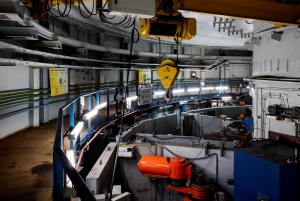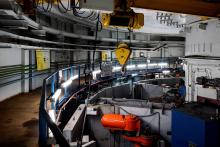Four modern instruments dedicated to neutron studies will soon come to Świerk according to an agreement reached between NCBJ and Helmholtz-Zentrum Berlin. The instruments will certainly expand opportunities to conduct neutron experiments at the MARIA reactor research lab.
The instruments will come from the BER II reactor lab so far operated in the Helmholtz-Zentrum Berlin (HZB); the lab is scheduled to be shut down soon. The instruments will arrive to Świerk successively. A diffractometer capable to measure diffraction of neutrons within a wide solid angle around the tested sample and a diffractometer dedicated to study mono-crystals are expected first. NCBJ hopes to get also a diffractometer capable to generate 3D maps of plane-to-plane distances in the studied crystals. The possibility of transferring some other equipment (including a cryogenic setup for conducting measurements at extremely low temperatures and an equipment for conducting experiments in variable environmental conditions) is negotiated.
Preparatory work within the MARIA research reactor hall in Świerk where the new instruments are to be installed have been already started. Some existing instruments must be disassembled, some construction & adaptation works are necessary. Instrument elevation must be properly matched to elevation of exits from the reactor horizontal channels. Floor must be very solid and accurately levelled since the instruments will move on some air >cushions; therefore it will be made of some granite tiles. Świerk experts estimate that the new equipment will be ready for experiments in three years.
Some of neutrons produced in result of uranium fission within the MARIA research reactor core exit the reactor via the reactor six horizontal channels – explains Dr. Jacek Milczarek, Head of the NCBJ Nuclear Methods in Solid State Physics Division – Each exit may be surrounded with some equipment to conduct experiments. Examples of the research include neutronography (irradiation of objects with neutron beams), analysis of crystal structures by neutron scattering, donor/impurity analysis. Even if our equipment (for example radiographic setup) was among the best in the world as recently as a dozen or so years ago, currently it is old-fashioned. On the other hand the equipment from Berlin was systematically updated.
The equipment will be used not only by Polish scientists. The MARIA reactor is among a few facilities of the kind available in Europe, while demand for neutron beams for research on new materials is steadily growing. It is enough to say that capacity of the to-be-shut down HZB lab are fully booked till the end of its operations scheduled for 2019; the capacities are used by scientists from numerous countries, including Poland.
We hope that our colleagues from Cracow, Poznan or Bialystok will soon be able to conduct their research in our modern neutron lab in Świerk – said Dr. Krzysztof Kurek, NCBJ Director General – We wish our lab was available for researchers from all parts of the world. We also hope that the lab will be effectively supporting Polish programmes of development of nuclear technologies.







